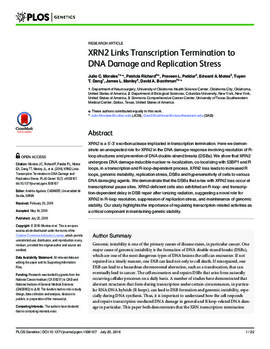| dc.contributor.author | Julio C. Morales | |
| dc.contributor.author | Patricia Richard | |
| dc.contributor.author | Praveen L. Patidar | |
| dc.contributor.author | Edward A. Motea | |
| dc.contributor.author | Tuyen T. Dang | |
| dc.contributor.author | James L. Manley | |
| dc.contributor.author | David A. Boothman | |
| dc.date.accessioned | 2017-03-05T23:40:51Z | |
| dc.date.available | 2017-03-05T23:40:51Z | |
| dc.date.issued | 2016-07-20 | |
| dc.identifier.citation | Morales JC, Richard P, Patidar PL, Motea EA, Dang TT, Manley JL, et al. (2016) XRN2 Links Transcription Termination to DNA Damage and Replication Stress. PLoS Genet 12(7): e1006107. doi:10.1371/journal.pgen.1006107 | en_US |
| dc.identifier.uri | https://hdl.handle.net/11244/49286 | |
| dc.description | We thank the Proteomics Core Facility. We thank Dr. Robert J. Crouch for providing us with GFP- and GFP-RNase H expression plasmids. We also thank Dr. Stephen H. Leppla for providing us with antibodies directed against RNA:DNA hybrids (R loops) (S9.6). We thank Novus Biologicals for generously providing XRN2 and Rrp45 antibodies. We also thank the members of the Boothman lab for critical reading of this manuscript. | en_US |
| dc.description | | en_US |
| dc.description.abstract | Author Summary Genomic instability is one of the primary causes of disease states, in particular cancer. One major cause of genomic instability is the formation of DNA double strand breaks (DSBs), which are one of the most dangerous types of DNA lesions the cell can encounter. If not repaired in a timely manner, one DSB can lead not only to cell death. If misrepaired, one DSB can lead to a hazardous chromosomal aberration, such as a translocation, that can eventually lead to cancer. The cell encounters and repairs DSBs that arise from naturally occurring cellular processes on a daily basis. A number of studies have demonstrated that aberrant structures that form during transcription under certain circumstances, in particular RNA:DNA hybrids (R loops), can lead to DSB formation and genomic instability, especially during DNA synthesis. Thus, it is important to understand how the cell responds and repairs transcription-mediated DNA damage in general and R loop-related DNA damage in particular. This paper both demonstrates that the XRN transcription termination factor links transcription and DNA damage, but also provides a better understanding of how the cell prevents transcription-related DNA damage. | en_US |
| dc.language.iso | en_US | en_US |
| dc.publisher | PLos Genetics | |
| dc.relation.ispartofseries | PLoS Genet 12(7): e1006107 | |
| dc.relation.uri | http://www.plosgenetics.org/article/info%3Adoi%2F10.1371%2Fjournal.pgen.1006107 | |
| dc.rights | Attribution 3.0 United States | |
| dc.rights.uri | https://creativecommons.org/licenses/by/3.0/us/ | |
| dc.subject | DNA damage,Small interfering RNAs,Non-homologous end joining,Fibroblasts,DNA transcription,DNA repair,DNA replication,Genetic networks | en_US |
| dc.title | XRN2 Links Transcription Termination to DNA Damage and Replication Stress | en_US |
| dc.type | Research Article | en_US |
| dc.description.peerreview | Yes | en_US |
| dc.description.peerreviewnotes | http://www.plosgenetics.org/static/editorial#peer | en_US |
| dc.identifier.doi | 10.1371/journal.pgen.1006107 | en_US |
| dc.rights.requestable | false | en_US |

